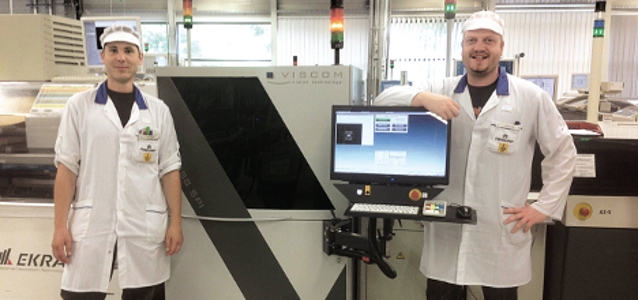
© Viscom
Electronics Production |
Marquardt relies on Viscom S3088 SPI
Marquardt GmbH of Rietheim-Weilheim (Germany), manufacturer of electromechanical and electronic switches and switch systems, uses the Viscom S3088 SPI3D solder paste inspection system.
The system detects all essential 3D characteristics of solder paste printing on electronic components, including height, shape, offset, smearing and contamination of the printing. Using the Viscom S3088 SPI system, Marquardt can reliably and quickly check the solder paste print quality. Additionally, the system offers easy operation and, with the Quality Uplink, is an efficient tool for process optimization.
Marquardt's mechatronic expertise is used commonly in automobiles, power tools, household appliances and industrial systems. "We produce our products in large quantities. In operation, they are frequently under great strain due to frequent switching. Therefore, quality is the decisive factor in our production," says Holger Gerst, who is responsible for testing systems at Marquardt. "With the Viscom S3088 SPI solder paste inspection system, we detect defects before the electronic components are assembled, which reduces reworking costs."
After using a system for 3D solder paste inspection, Marquardt evaluated various suppliers for six months. "We actually had already decided on a different machine when we took another look at the Viscom system," reports Holger Gerst. "In addition to reliable inspection, what ultimately convinced us was that this system had already won the bidding for a sophisticated EU-funded project, and that with Viscom we could formulate individual modifications and implement them in the system."
Marquardt has stabilized its printing process significantly with the Viscom S3088 SPI because all printing parameters can be adapted quickly and precisely. For example, the system immediately analyzes and detects potential problems, such as an incorrectly calibrated printing table or a misaligned circuit board, and informs the operator. "Additionally, we now know exactly how long we can use a template until the next cleaning," reports Holger Gerst. "This reduces line downtime and keeps quality of production at a consistently high level."
He continues, "Especially promising is the possibility of linking the SPI results to the results of the EOL AOI, which we soon will be installing in cooperation with Viscom. Until now, we have been able to determine the necessary configuration parameters for our line configuration with Viscom. Next, we plan to install the Quality Uplink function on a production line to reduce scrap, improve first pass yield and thus improve the entire SMT process."




